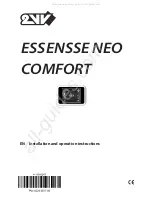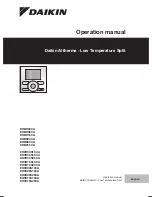
24-5
Chapter 24: Thermocouple Input Module
Termination is required at the extreme ends of the communications network to minimize sig-
nal reflections that would otherwise cause data communication errors. To activate the Bus
Termination, move the jumper to the IN position. Note that this should only be activated if
the module is at the very end of the network. All other modules in between should have the
termination set to the OUT position. As a result, only 1 module should ever have the termina-
tion activated. The diagram below illustrates proper termination of the communications bus.
Figure 6: Correct bus termination
Thermocouple Wiring Information
The Thermocouple Input Module features four thermocouple inputs that can be independent-
ly configured to accept type E, J, K, T, R, or S thermocouples. The configuration is selected
by moving the jumper behind the terminal strip into the appropriate position (see Wiring &
Jumpers figure following).
There are thermocouples available for virtually every kind of application (surface measurement,
liquid, semi-solids, gas or vacuum, ovens, molds, dies, etc…). Only thermocouples that are
type E, J, K, T, R, & S are compatible with the Thermocouple Input Module. Manufacturers
of thermocouples can help you select the best thermocouple for your application.
Thermocouples can be connected directly to the input terminals but be sure to match the
polarity markings on the module with the thermocouple. In the thermocouple industry, stan-
dard practice is to color the negative lead red. Bare wire thermocouples usually make the
negative lead shorter than the positive one. On thermocouples with a connector, the large pin
is always the negative conductor. When adding extension wire to a thermocouple sensor, you
must always use thermocouple alloy wire to assure accurate measurements. The following dia-
gram shows several thermocouples connected to the module:
Figure 7: Thermocouple Wiring & Jumpers
To minimize electrical noise coupling between I/O lines, follow the guidelines listed below for
routing your wires:
• Route the power supply and communications cables to the module by a separate
path from wiring to I/O devices. Where paths must cross, their intersection
should be perpendicular.
• Do not run signal or communications wiring and power in the same conduit.
Содержание Sensaphone SCADA 3000
Страница 1: ...Sensaphone SCADA 3000 User s Manual Version 2 34...
Страница 6: ...vi SCADA 3000 User s Manual...
Страница 10: ...x SCADA 3000 User s Manual...
Страница 30: ...1 6 SCADA 3000 User s Manual...
Страница 48: ...4 6 SCADA 3000 User s Manual...
Страница 70: ...9 8 SCADA 3000 User s Manual...
Страница 122: ...12 8 SCADA 3000 User s Manual...
Страница 190: ...15 30 SCADA 3000 User s Manual...
Страница 211: ...lead 1 lag 0 else lead 0 lag 1 16 21 Chapter 16 Programming in C...
Страница 212: ...16 22 SCADA 3000 User s Manual...
Страница 236: ...21 8 SCADA 3000 User s Manual...
Страница 248: ...22 12 SCADA 3000 User s Manual...
Страница 258: ...23 10 SCADA 3000 User s Manual...
Страница 274: ...25 8 SCADA 3000 User s Manual...
Страница 288: ...27 8 SCADA 3000 User s Manual...
Страница 294: ...28 6 SCADA 3000 User s Manual...
Страница 296: ...A 2 SCADA 3000 User s Manual...
Страница 302: ...D 2 SCADA 3000 User s Manual...
Страница 318: ...I 2 SCADA 3000 User s Manual...
Страница 320: ...J 2 SCADA 3000 User s Manual...
Страница 322: ...K 2 SCADA 3000 User s Manual...
Страница 335: ...Test Log...
Страница 336: ......
















































